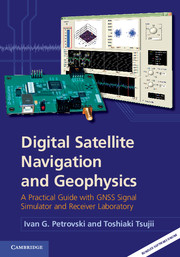 Digital Satellite Navigation and Geophysics
Digital Satellite Navigation and Geophysics Book contents
- Frontmatter
- Contents
- Foreword
- Preface
- 1 Methods of positioning with navigation satellites
- 2 Presentations and applications of GNSS orbits
- 3 GNSS signal generation in transmitters and simulators
- 4 Signal propagation throughthe atmosphere
- 5 Receiver RF front end
- 6 Real-time baseband processor on a PC
- 7 Multipath
- 8 Optimization of GNSS observables
- 9 Using observables in navigation-related tasks
- 10 Electromagnetic scintillation of GNSS signal
- 11 Geophysical measurements using GNSS signals
- 12 Aiding baseband and navigation processors using INS
- Next step – RF lab
- Index
- References
11 - Geophysical measurements using GNSS signals
Published online by Cambridge University Press: 05 March 2012
- Frontmatter
- Contents
- Foreword
- Preface
- 1 Methods of positioning with navigation satellites
- 2 Presentations and applications of GNSS orbits
- 3 GNSS signal generation in transmitters and simulators
- 4 Signal propagation throughthe atmosphere
- 5 Receiver RF front end
- 6 Real-time baseband processor on a PC
- 7 Multipath
- 8 Optimization of GNSS observables
- 9 Using observables in navigation-related tasks
- 10 Electromagnetic scintillation of GNSS signal
- 11 Geophysical measurements using GNSS signals
- 12 Aiding baseband and navigation processors using INS
- Next step – RF lab
- Index
- References
Summary
“And whilst all these nations have magnified their Antiquities so exceedingly, we need not wonder that the Greeks and Latines have made their first Kings a little older then the truth.”
Sir Isaac Newton, The Chronology of Ancient Kingdoms, Chap. VI.Though GNSS satellites are just some among many other satellites which are implemented for geophysical measurements, GNSS play a very significant and increasing role in collecting geophysical data. They have become an indispensable tool for many geophysical applications. Apart from this, GNSS satellites have also allowed spread spectrum radiowave technology to mature. This technology can be used on its own for atmosphere probing in other parts of the electromagnetic spectrum than GNSS’s. Together with other atmosphere sensing instruments, GNSS provides information for weather prediction and monitoring climate change. GNSS has also become an essential tool for estimation of the Earth’s rotation parameters. There are also emerging areas of paramount importance, which are yet under development, such as using GNSS signals for earthquake studies. Figure 11.1 depicts the subject of this chapter in relation to other chapters in this book.
Data from global reference networks are routinely used to monitor movement of the Earth’s tectonic plates relative to each other and to an inertial frame. In this task the same type of GNSS observables as described in Chapter 8 are used. Such observables are created using measurements from globally distributed networks of GNSS receivers, supplying various data in raw data formats, mostly in RINEX. The most prominent among such networks is the IGS network. There are also various regional and local networks, which can provide large volumes of geophysical information. Among such networks, for example, is the Geographical Survey Institute (GSI) network in Japan, which consists of more than 1200 high-end geodetic GNSS receivers. The data from these networks include code and carrier phase measurements, Doppler measurements, and signal-to-noise ratio. All measurements are delivered from dual frequency receivers using two frequencies (L1, L2). We consider implementation of data from such networks in Sections 11.1, 11.3, and 11.4.
Information
- Type
- Chapter
- Information
- Digital Satellite Navigation and GeophysicsA Practical Guide with GNSS Signal Simulator and Receiver Laboratory, pp. 270 - 292Publisher: Cambridge University PressPrint publication year: 2012